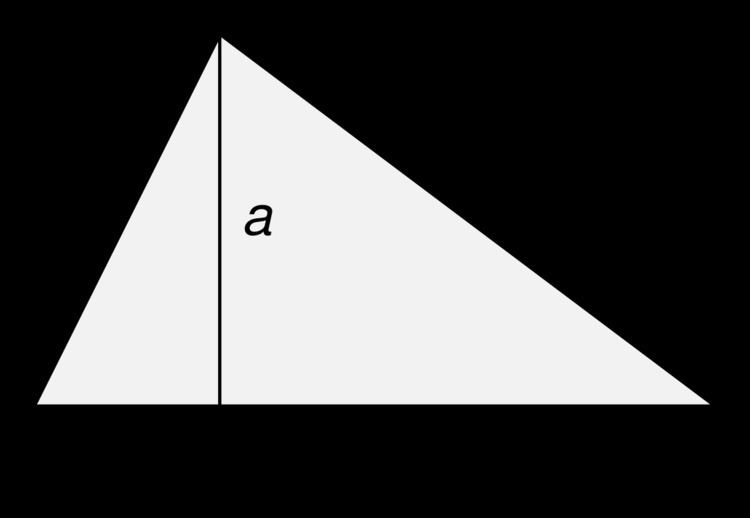 | ||
In geometry, a Heronian triangle is a triangle that has side lengths and area that are all integers. Heronian triangles are named after Hero of Alexandria. The term is sometimes applied more widely to triangles whose sides and area are all rational numbers.
Contents
Properties
Any right-angled triangle whose sidelengths are a Pythagorean triple is a Heronian triangle, as the side lengths of such a triangle are integers, and its area is also an integer, being half of the product of the two shorter sides of the triangle, at least one of which must be even.
An example of a Heronian triangle which is not right-angled is the isosceles triangle with sidelengths 5, 5, and 6, whose area is 12. This triangle is obtained by joining two copies of the right-angled triangle with sides 3, 4, and 5 along the sides of length 4. This approach works in general, as illustrated in the adjacent picture. One takes a Pythagorean triple (a, b, c), with c being largest, then another one (a, d, e), with e being largest, constructs the triangles with these sidelengths, and joins them together along the sides of length a, to obtain a triangle with integer side lengths c, e, and b + d, and with area
If a is even then the area A is an integer. Less obviously, if a is odd then A is still an integer, as b and d must both be even, making b+d even too.
Some Heronian triangles cannot be obtained by joining together two right-angled triangles with integer sides as described above. For example, a 5, 29, 30 Heronian triangle with area 72 cannot be constructed from two integer Pythagorean triangles since none of its altitudes are integers. Also no primitive Pythagorean triangle can be constructed from two smaller integer Pythagorean triangles. Such Heronian triangles are known as indecomposable. However, if one allows Pythagorean triples with rational values, not necessarily integers, then a decomposition into right triangles with rational sides always exists, because every altitude of a Heronian triangle is rational (since it equals twice the integer area divided by the integer base). So the Heronian triangle with sides 5, 29, 30 can be constructed from rational Pythagorean triangles with sides 7/5, 24/5, 5 and 143/5, 24/5, 29. Note that a Pythagorean triple with rational values is just a scaled version of a triple with integer values.
Other properties of Heronian triangles are given in Integer triangle#Heronian triangles.
Exact formula for Heronian triangles
The Indian mathematician Brahmagupta (598-668 A.D.) derived the parametric solution such that every Heronian triangle has sides proportional to:
for integers m, n and k where:
The proportionality factor is generally a rational p⁄q where q = gcd(a, b, c) reduces the generated Heronian triangle to its primitive and p scales up this primitive to the required size. For example, taking m = 36, n = 4 and k = 3 produces a triangle with a = 5220, b = 900 and c = 5400, which is similar to the 5, 29, 30 Heronian triangle and the proportionality factor used has p = 1 and q = 180.
The obstacle for a computational use of Brahmagupta’s parametric solution is the denominator q of the proportionality factor. q can only be determined by calculating the greatest common divisor of the three sides ( gcd(a, b, c) ) and introduces an element of unpredictability into the generation process. The easiest way of generating lists of Heronian triangles is to generate all integer triangles up to a maximum side length and test for an integral area.
Faster algorithms have been derived by Kurz (2008).
See also formulas for Heronian triangles with one angle equal to twice another, Heronian triangles with sides in arithmetic progression, and isosceles Heronian triangles.
Examples
The list of primitive integer Heronian triangles, sorted by area and, if this is the same, by perimeter, starts as in the following table. "Primitive" means that the greatest common divisor of the three side lengths equals 1.
Lists of primitive Heronian triangles whose sides do not exceed 6,000,000 can be found at "Lists of primitive Heronian triangles". Sascha Kurz, University of Bayreuth, Germany. Retrieved 29 March 2016.
Equable triangles
A shape is called equable if its area equals its perimeter. There are exactly five equable Heronian triangles: the ones with side lengths (5,12,13), (6,8,10), (6,25,29), (7,15,20), and (9,10,17).
Almost-equilateral Heronian triangles
Since the area of an equilateral triangle with rational sides is an irrational number, no equilateral triangle is Heronian. However, there is a unique sequence of Heronian triangles that are "almost equilateral" because the three sides are of the form n − 1, n, n + 1. A method for generating all solutions to this problem based on continued fractions was described in 1864 by Edward Sang, and in 1880 Reinhold Hoppe gave a closed-form expression for the solutions. The first few examples of these almost-equilateral triangles are listed in the following table (sequence A003500 in the OEIS):
Subsequent values of n can be found by multiplying the previous value by 4, then subtracting the value prior to that one (52 = 4 × 14 − 4, 194 = 4 × 52 − 14, etc.), thus:
where t denotes any row in the table. This is a Lucas sequence. Alternatively, the formula
where {n, y} are solutions to n2 − 12y2 = 4. A small transformation n = 2x yields a conventional Pell equation x2 − 3y2 = 1, the solutions of which can then be derived from the regular continued fraction expansion for √3.
The variable n is of the form
